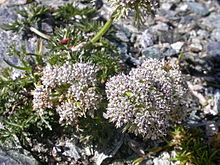| Ligusticum | |
|---|---|

| |
| Ligusticum mutellinoides | |
| Scientific classification | |
| Kingdom: | Plantae |
| Clade: | Tracheophytes |
| Clade: | Angiosperms |
| Clade: | Eudicots |
| Clade: | Asterids |
| Order: | Apiales |
| Family: | Apiaceae |
| Subfamily: | Apioideae |
| Genus: | Ligusticum L. |
| Type species | |
| Ligusticum scoticum L. [1]
| |
Ligusticum (lovage,[2]: 824 licorice root[3]) is a genus of about 60 species of flowering plants in the family Apiaceae,[4] native to cool temperate regions of the Northern Hemisphere. Its name is believed to derive from the Italian region of Liguria.[5]
Species[edit]
- Ligusticum ajanense
- Ligusticum albanicum
- Ligusticum apiifolium
- Ligusticum brachylobum
- Ligusticum calderi
- Ligusticum californicum
- Ligusticum canadense
- Ligusticum canbyi - Canby's licorice root
- Ligusticum filicinum
- Ligusticum gingidium
- Ligusticum grayi - oshala, Gray's lovage
- Ligusticum holopetalum
- Ligusticum hultenii
- Ligusticum huteri
- Ligusticum ibukicola
- Ligusticum jeholense
- Ligusticum monnieri
- Ligusticum mutellina – alpine lovage
- Ligusticum porteri – oshá
- Ligusticum scoticum – Scots lovage
- Ligusticum sinense – gaoben 藁本
- Ligusticum striatum - Szechuan lovage, Szechwan lovage, chuanxiong, chuan xiong 川芎
- Ligusticum tenuifolium – Idaho lovage
- Ligusticum vaginatum
- Ligusticum verticillatum – northern lovage
Former species[edit]
Ligusticum mutellinoides – small alpine lovage, is a synonym of Neogaya simplex (L.) Meisn.[6]
Uses[edit]
The roots of several species are used as medicinal herbs. L. striatum (in older literature L. wallichi or L. chuanxiong) is one of the 50 fundamental herbs used in Chinese herbology, where it is called chuānxiōng (川芎); in English, Szechwan lovage.[7] L. porteri (osha) is used in Western herbal medicine. Chinese Ligusticum root contains alkaloids that have been shown in studies to inhibit TNF-alpha production and TNF-alpha-mediated NF-kappaB activation.[8] One study conducted in Japan showed the active compounds found in Ligusticum sinense have both anti-inflammatory and pain-reducing effects, exerting its anti-inflammatory benefits in the early and the late stages of processes in the inflammatory pathology.[9]
Both Ligusticum sinense and L. jeholens essential oils contain natural antimicrobial and antioxidant agents.[10]
References[edit]
- ^ Le Roy Abrams; Roxana Stinchfield Ferris (1923). "Ligusticum L. Sp. Pl. 250. 1753". Geraniaceae to Scrophulariaceae, geraniums to figworts. An Illustrated Flora of the Pacific States: Washington, Oregon, and California. Vol. 3. Stanford University Press. pp. 235–237. ISBN 9780804700054.
- ^ Stace, C. A. (2010). New Flora of the British Isles (Third ed.). Cambridge, U.K.: Cambridge University Press. ISBN 9780521707725.
- ^ USDA, NRCS (n.d.). "Ligusticum". The PLANTS Database (plants.usda.gov). Greensboro, North Carolina: National Plant Data Team. Retrieved 2 June 2015.
- ^ Menglan She; Fading Pu; Zehui Pan; Mark Watson; John F. M. Cannon; Ingrid Holmes-Smith; Eugene V. Kljuykov; Loy R. Phillippe; Michael G. Pimenov (2005). "Ligusticum Linnaeus, Sp. Pl. 1: 250. 1753". In Flora of Chinaial Committee; Wu Zhengyi; Peter Raven (eds.). Apiaceae through Ericaceae. Flora of China. Vol. 14. Science Press & Missouri Botanical Garden Press. ISBN 9781930723412.
- ^ Huxley, A., ed. (1992). New RHS Dictionary of Gardening. Macmillan ISBN 0-333-47494-5.
- ^ "Neogaya simplex". Plants of the World Online. Royal Botanic Gardens, Kew. Retrieved 2 November 2021.
- ^ "Page about use in Chinese medicine". Archived from the original on 2006-10-29. Retrieved 2006-10-16.
- ^ Prieto JM, Recio MC, Giner RM, Máñez S, Giner-Larza EM, Ríos JL (2003). "Influence of traditional Chinese anti-inflammatory medicinal plants on leukocyte and platelet functions". J Pharm Pharmacol. 9 (55): 1275–82. Archived from the original on 2011-12-10. Retrieved 2012-01-05.
- ^ Jim English (2010). "Traditional Chinese Herbs for Arthritis". Nutrition Review. 5 (2). Archived from the original on 2011-12-10. Retrieved 2011-12-29.
- ^ Jihua Wang, Liang Xu, Ling Yang, Zhilong Liu and Ligang Zhou "Composition, Antibacterial and Antioxidant Activities of Essential Oils from Ligusticum sinense and L. jeholense (Umbelliferae) from China" Rec. Nat. Prod. 5:4 (2011) 314-318 Records of Natural Products